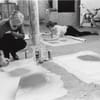Are you stuck in a creative rut? Here we’ll guide you through the creative process, exploring the different steps and techniques to help you bring your ideas to life.
The creative process is personal and unique to each artist, and it can take many forms depending on the medium, subject matter, and personal approach. Some begin with a clear idea or vision and work to bring it to life, while others are more exploratory and allow their piece to evolve over time. Many artists also emphasize the importance of taking risks, experimenting with new materials and techniques, and not trying to eschew failure.
Fearing the creative process is a shared experience; creativity is not always a smooth process. It can be messy, unpredictable, and sometimes frustrating. However, allow yourself to embrace uncertainty and make mistakes – because that is often where some of the best ideas and breakthroughs come to life.
The 5 Steps of the Creative Process
The creative process has been studied in psychology, neuroscience, and cognitive science. Graham Wallas, a social psychologist and co-founder of the London School of Economics wrote a book called “The Art of Thought” in 1926, in which he outlined the primary 5 stages of the creative process:
- Preparation
- Incubation
- Illumination
- Evaluation
- Verification
During preparation, the artist collects information, identifies the problem or challenge, and explores potential solutions. The incubation stage involves stepping away from the situation and allowing the mind to subconsciously work on it. The illumination stage is the “aha” moment where a solution or new idea comes to light.
During the evaluation stage, the artist assesses the solution or idea and decides if it is viable. Finally, the verification stage involves testing the idea or solution to ensure it works and meets the necessary criteria.
Overall, Wallas believed that the creative process involves both conscious and subconscious thinking and that by following these stages, individuals can bring their ideas to fruition.
Tap into the Subconscious
Subconscious thinking can be a powerful tool to enhance your creative process. It refers to the mental activity that occurs outside our awareness yet still influences our thoughts, feelings, and behaviors. The subconscious mind provides a wealth of inspiration and ideas that may not have been accessible through conscious thought alone.
This is especially beneficial during the incubation stage after an initial period of conscious thought and brainstorming, where your mind can wander and make connections between seemingly unrelated ideas. During this time, it processes and integrates the information gathered and presents new insights or perspectives that the conscious mind has yet to consider. By tapping into our subconscious through meditation, mindfulness, or other practices, you may be able to access these more profound levels of creativity and generate more innovative ideas.
Think like Galileo
Another aspect proven beneficial is the ability of divergent thinking, a cognitive process that involves generating multiple ideas or solutions to a problem. Studies have shown that creatives tend to have higher levels of divergent thinking ability.
In cognitive science, the Alternate Uses Task (AUT) is a standard method in laboratory settings to assess an individual’s ability to think divergently. During the task, scientists present a cue word like ‘newspaper’ to the participant, and then ask to devise unconventional and imaginative uses for the object (e.g., ‘using it as an umbrella’). It’s worth noting that the performance of individuals on the AUT test associates directly with their creative thinking abilities in real-world settings.
Fortunately, divergent thinking is also a skill people can train through brainstorming, mind mapping, and creative problem-solving exercises. This ability to think outside the box comes naturally to kids, as children have a more open and less constrained way of thinking. It allows them to explore endless possibilities and develop idiosyncratic reasoning that helps them stand out. However, thinking differently is not just a skill. It’s also a brave act. Galileo risked everything to challenge the status quo and, in the end, was confined to a house in Florence due to his ideology.

Focus on Flow
As a creative or a scientist, you are very likely familiar with the feeling of flow, a state of deep focus and immersion in a task that can lead you to creative insights. Research has shown that the flow state emerges by engaging in challenging but not too tricky activities that provide immediate feedback. Since its introduction, flow has been widely studied and applied in various fields, including psychology, sports, education, and business.
The term “flow” was first coined by psychologist Mihaly Csikszentmihalyi in his seminal book “Flow: The Psychology of Optimal Experience,” published in 1990. In it, he describes flow as a state of complete absorption in an activity, where a person is entirely focused, energized, and deeply engaged in the present moment. Since its introduction, flow has been widely studied and applied in various fields, including psychology, sports, education, and business. To help you enter the flow state, here are some tips:
- Find a quiet and comfortable environment where you can focus on the task without interruption. Turn off your phone, close unnecessary tabs on your computer, and clear your workspace of anything that might distract you.
- Define your goal and break the task into smaller, manageable steps. Having clear objectives and a plan can help you stay on track and avoid getting overwhelmed.
- Engage in an activity that is challenging enough to hold your attention but not so complex that it leads to frustration. If the action is too easy, you may become bored, but if it’s too difficult, you may become discouraged.
- Focus on the present: Avoid dwelling on past mistakes or worrying about future outcomes. Focus your attention on the present moment and the task at hand.
- Try to maintain control over the activity. If you feel you are losing control, take a break, reassess your goals, and adjust your approach as needed.
- Search out feedbacks it can help you stay on track and adjust your approach as needed. Seek input from a mentor, coach, or colleague who can provide objective and constructive criticism.
The Creative Process According to James Baldwin
James Baldwin wrote an essay titled “The Creative Process,” which was first published in 1962. In it, Baldwin explores the nature of creativity and the artist’s role in society.
He argues that the creative process is a journey of self-discovery in which the artist must confront their fears and desires to create something meaningful. He also suggests that the creative process inherently links to social and political issues, as artists often grapple with the complexities of the world around them in their work.
Baldwin also emphasizes the importance of authenticity in the creative process, suggesting that artists must be true to their own vision and experience rather than conform to societal norms or expectations. He writes, “The precise role of the artist, then, is to illuminate that darkness, blaze roads through that vast forest, so that we will not, in all our doing, lose sight of its purpose, which is, after all, to make the world a more human dwelling place.”
Baldwin’s essay on the creative process reflects his deep understanding of the challenges and rewards of artistic expression and his belief in the transformative power of art.

Don’t overthink it
Andy Warhol has made several notable comments about the creative process throughout his career. The most important of them is: “Don’t think about making art, get it done. Let everyone else decide if it’s good or bad, whether they love it or hate it. While they are deciding, make even more art.”
Warhol believed that creating was more critical than overthinking or analyzing the creative process. He encouraged artists to focus on producing as much pieces as possible rather than worrying about the quality of the work or how others would receive it.
Warhol suggests that the audience, rather than the artist, should be the ones to decide whether a work of art is good or bad and that the artist should simply create and let the public decide. He also believed that creating a large quantity of work was more important than making a few masterpieces, as it allowed the artist to experiment and explore new ideas.
Overall, the importance of taking risks and being prolific as an artist and his philosophy has influenced many artists who embrace a more intuitive and experimental approach to creating art.
The fears of being judged and criticized Warhol addresses here can paralyze and prevent you from pursuing your goals or fully expressing yourself. However, by acknowledging and working through these fears, you can set your creativity free and ultimately achieve tremendous success in your artistic pursuits.





